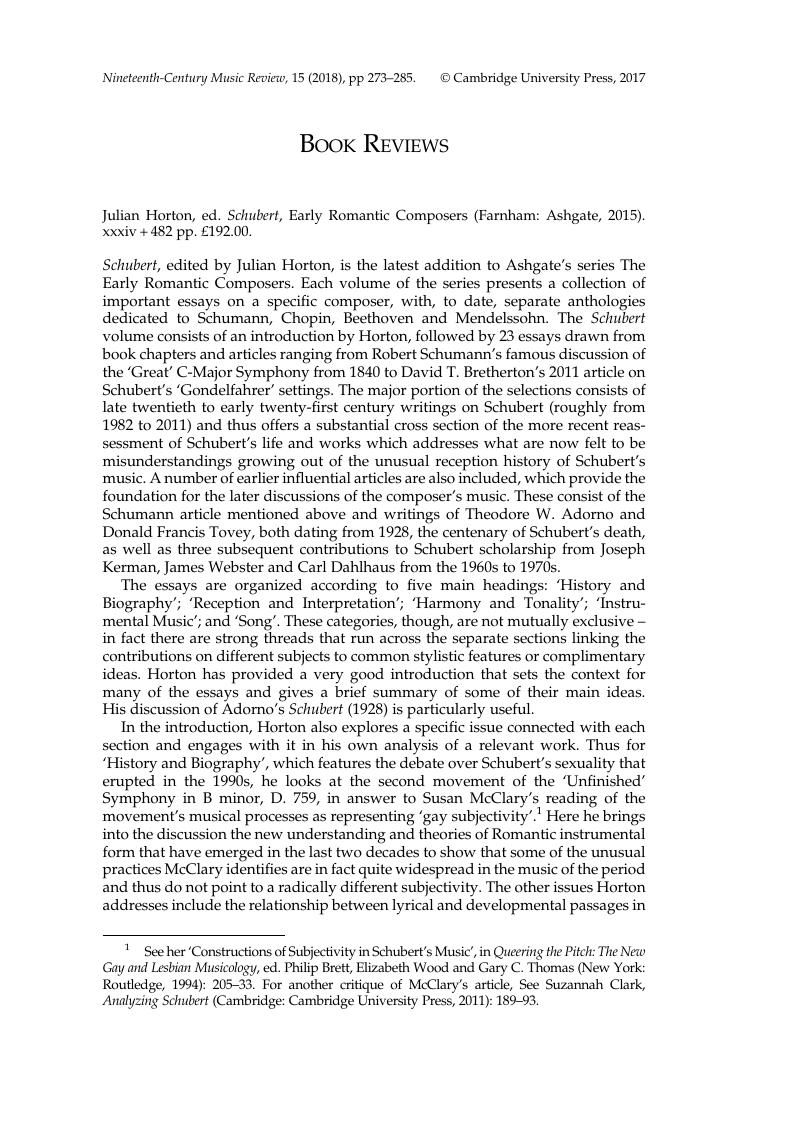No CrossRef data available.
Article contents
Julian Horton, ed. Schubert, Early Romantic Composers (Farnham: Ashgate, 2015). xxxiv+482 pp. £192.00.
Review products
Published online by Cambridge University Press: 10 November 2017
Abstract

- Type
- Book Reviews
- Information
- Copyright
- © Cambridge University Press 2017
References
1 See her ‘Constructions of Subjectivity in Schubert’s Music’, in Queering the Pitch: The New Gay and Lesbian Musicology, ed. Philip Brett, Elizabeth Wood and Gary C. Thomas (New York: Routledge, 1994): 205–33. For another critique of McClary’s article, See Clark, Suzannah, Analyzing Schubert (Cambridge: Cambridge University Press, 2011): 189–193 CrossRefGoogle Scholar.
2 See Rosen, Charles, The Classical Style (New York: W.W. Norton, 1972): 57–64 Google Scholar, for a discussion of the importance of rhythmic variety and balanced periodicity in the classical style.
3 See his ‘Sonatenform bei Franz Schubert’, in Studien zur Musikwissenschaft 15 (1928): 86–125 Google Scholar. For a translation and excellent commentary, see Mak, Su Yin, ‘Felix Salzer’s “Sonata Form in Franz Schubert” (1928): An English Translation and Edition with Critical Commentary’, Theory and Practice 40 (2015): 1–121 Google Scholar.
4 For a discussion of the unusual structure of Schubert’s early sonata-form movements, see Brian Black, ‘Schubert’s Apprenticeship in Sonata Form: The Early String Quartets’ (PhD diss., McGill University, 1997).
5 Susan McClary describes the intensity of this debate in relation to the reaction to her own work in ‘Constructions of Subjectivity in Schubert’s Music’, 205–9.
6 Winter, ‘Whose Schubert?’19 th –Century Music 17/1 (Summer 1993): 94–101.
7 See Webster, ‘Music, Pathology, Sexuality, Beethoven, Schubert’ 19 th –Century Music 17/1 (Summer 1993): 93.
8 Rita Steblin’s valuable contributions to Schubert scholarship are too numerous to list here. The following are just two highlights. Her discovery of Schubert’s membership along with others of his circle in the Unsinnsgesellschaft or Nonsense Society as well as 29 illustrated issues of the Society’s publication Archiv des mennschlichen Unsinns provides a revealing glimpse into the aesthetic and political ideas of Schubert and his friends as well as new biographical material and images. See Steblin, Die Unsinnsgesellschaft: Franz Schubert, Leopold Kupelwieser und ihr Freundeskreis (Vienna: Böhlau, 1998). Equally important are the memoirs of Joseph Lanz she has recently uncovered which provide a fascinating portrait of Schubert in the last few years of his life. See Steblin and Frederick Stocken, ‘Studying with Sechter: Newly Recovered Reminiscences about Schubert by his Forgotten Friend, the Composer Joseph Lanz’, Music and Letters 88/2 (2007): 226–65. Steblin is also an important researcher in the fields of Beethoven and Haydn biography.
9 See the translation and commentary by Su Yin Mak referenced in footnote 3 above.
10 This is especially true of the chapters by David Kopp and David Damschroder. For Kopp, see the opening chapter ‘Common-Tone Tonality’ in Chromatic Transformations in Nineteenth-Century Music (Cambridge: Cambridge University Press, 2002). For Damschroder, it would be good to read through Part I of the book to understand his system of harmonic analysis. See his Harmony in Schubert (Cambridge: Cambridge University Press, 2010).




